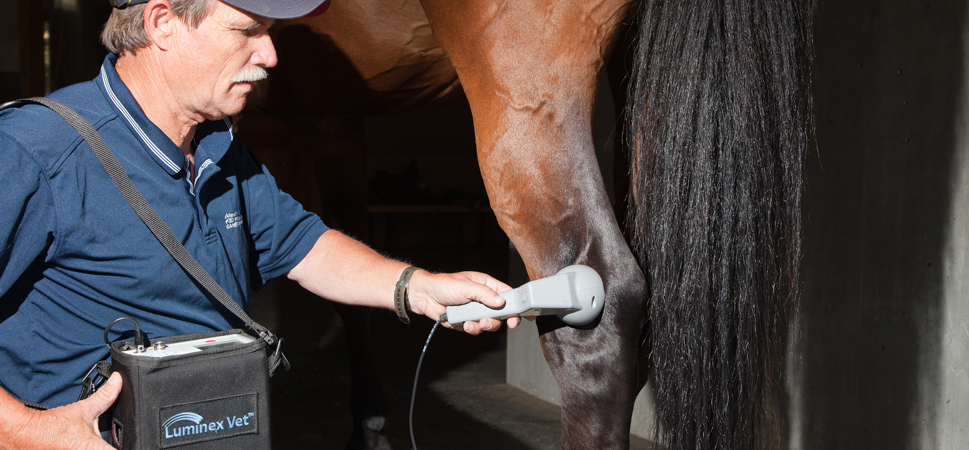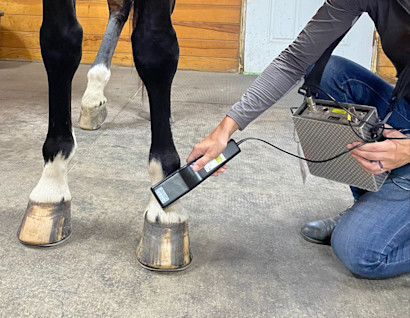Equine Therapy for Trauma Recovery: How Horses Assist Heal Emotional Wounds
Equine Therapy for Trauma Recovery: How Horses Assist Heal Emotional Wounds
Blog Article
Laser Therapy in Horse Treatment: A Modern Method to Improving Steed Health
Laser treatment has arised as a crucial technique in equine therapy, making use of concentrated light energy to foster mobile repair work and quicken healing from a variety of disorders. This non-invasive method is specifically efficient in taking care of musculoskeletal injuries, injuries, and inflammatory problems, substantially boosting overall steed wellness. By boosting mitochondrial task and enhancing ATP manufacturing, laser therapy not only improves flow however additionally offers significant discomfort alleviation. As this cutting-edge treatment continues to gain grip, it opens intriguing possibilities for attending to persistent conditions like arthritis and unguis issues, indicating a transformative shift in veterinary treatment. What makes this modality particularly engaging?
Comprehending Laser Therapy
Laser treatment, a non-invasive treatment modality, has obtained substantial traction in equine medication as a result of its efficacy in advertising recovery and pain relief. This innovative healing technique makes use of concentrated light energy to penetrate tissues, cultivating mobile repair work and regeneration. The underlying device entails the stimulation of mobile mitochondria, causing raised production of adenosine triphosphate (ATP), the power money of cells. Enhanced ATP levels accelerate cells repair processes and minimize swelling, making laser therapy especially effective for dealing with bone and joint injuries, wounds, and other inflammatory problems in horses.
There are a number of kinds of lasers used in equine treatment, each with details wavelengths and power outcomes customized to various therapeutic demands. Low-level laser treatment (LLLT), additionally called cold laser therapy, uses lower power degrees to stimulate cell function without causing thermal damage. High-intensity laser treatment (HILT), on the other hand, uses greater power degrees to accomplish deeper cells penetration and more significant restorative impacts.
Veterinarians utilize different laser devices and methods depending upon the condition being treated and the preferred deepness of tissue infiltration. Proper training and knowledge are important for guaranteeing the risk-free and efficient application of laser treatment, thereby maximizing its restorative capacity while lessening risks.
Benefits for Horse Wellness
With a strong understanding of just how laser treatment functions, it is essential to discover its many benefits for equine health and wellness. One of the main benefits is its capability to speed up tissue fixing and cell development. By boosting cellular feature, laser therapy advertises faster wound recovery and aids in the regrowth of broken tissues. This can be especially helpful in lowering healing times for steeds struggling with injuries.
Furthermore, laser treatment has been revealed to improve blood circulation, therefore boosting blood flow to affected areas. Improved blood circulation makes sure that important nutrients and oxygen are provided much more efficiently, assisting in the recovery procedure. Additionally, laser treatment's anti-inflammatory results help in lowering swelling and pain, which is view vital for the overall health of the horse.
Pain administration is one more considerable advantage. By launching endorphins and blocking pain signals, laser therapy supplies efficient, non-invasive remedy for both acute and chronic discomfort. This can contribute to boosted mobility and lifestyle for the animal.
Finally, laser treatment is a non-invasive therapy alternative, decreasing the risk of issues related to even more intrusive treatments. Its adaptability and efficiency make it a very useful tool in modern-day equine veterinary medication.
Common Conditions Dealt With

An additional prevalent condition treated with laser treatment is joint inflammation. In addition, laser treatment is employed in the administration of wounds.
Horse respiratory system problems, such as persistent air passage blockage (RAO), also respond positively to laser therapy. The anti-inflammatory residential properties of the therapy aid in lowering airway swelling, thus enhancing respiratory system my link feature. Laser therapy is useful in dealing with hoof issues, including laminitis and abscesses. By enhancing circulation and decreasing pain, it supports quicker recovery.
Treatment and Safety
Executing laser treatment in equine therapy includes a careful treatment to guarantee both efficiency and security. Equine Therapy. The process starts with a detailed veterinary assessment to identify the suitability of laser therapy for the horse's particular condition. Once considered suitable, the treatment location is prepared by cleaning and, if needed, clipping the hair to improve laser penetration
The practitioner must select the right kind of laser, typically a low-level laser (LLLT) or a high-power laser (HPL), depending on the problem being treated. The laser device is then calibrated to the ideal wavelength, power, and period setups. Throughout the application, the expert relocates the laser over the targeted location in a methodical way, making sure regular and even direct exposure.
Security protocols are purely stuck to, including making use of safety eyeglasses for both the expert and the equine. In addition, it is critical to keep track of the equine for any kind of signs of discomfort or damaging responses throughout the procedure. Post-treatment, the horse is commonly given a duration of remainder to permit the healing effects to manifest.

Future of Equine Laser Therapy
As advancements in vet medicine continue to unfold, the future of equine laser therapy holds considerable guarantee. Emerging innovations and much deeper clinical understandings are established to improve and increase the applications of laser treatment for steeds.
Additionally, recurring research study into the molecular and cellular devices of laser treatment will likely yield maximized procedures tailored to certain conditions, boosting efficiency and minimizing treatment times. Individualized treatment plans based upon genetic and biochemical markers can become a truth, ensuring that each equine receives the most ideal and reliable care.
Furthermore, governing improvements and standardization my explanation of procedures will certainly boost the trustworthiness and reliability of laser therapy in equine method. Equine Therapy. As these innovations remain to emerge, equine laser therapy is positioned to become an indispensable element of vet treatment, offering improved recovery and enhanced lifestyle for equines internationally
Verdict

Report this page